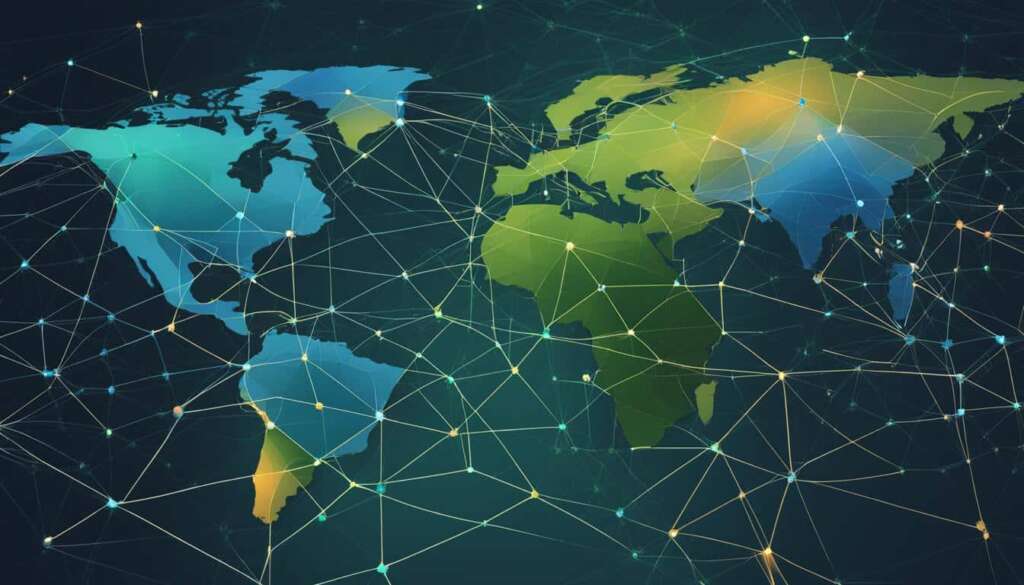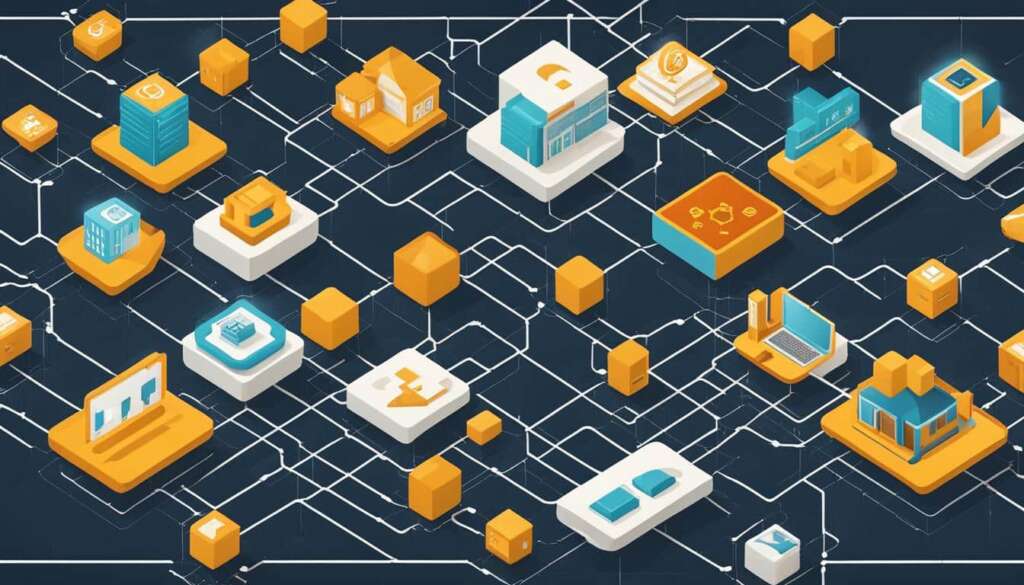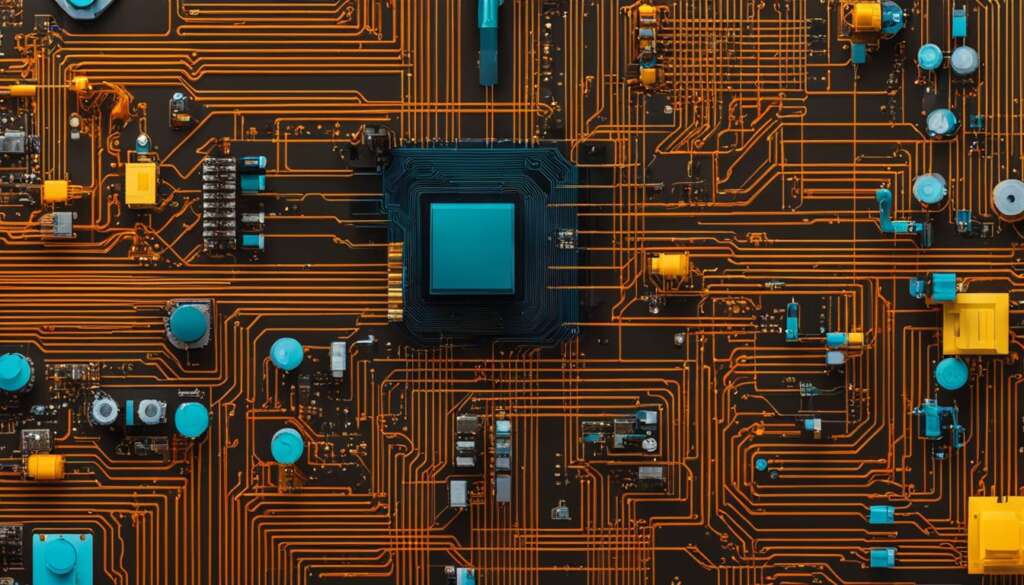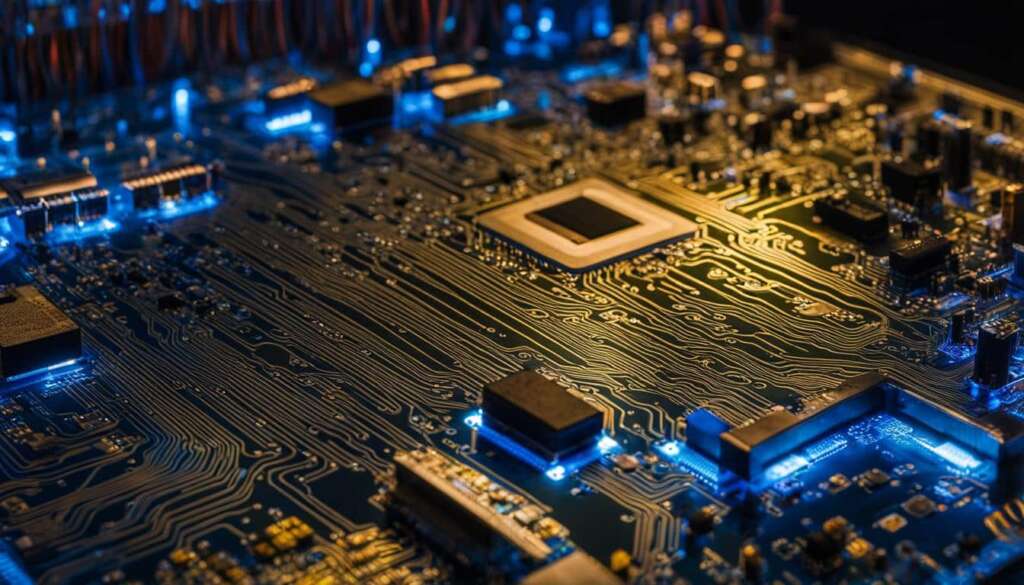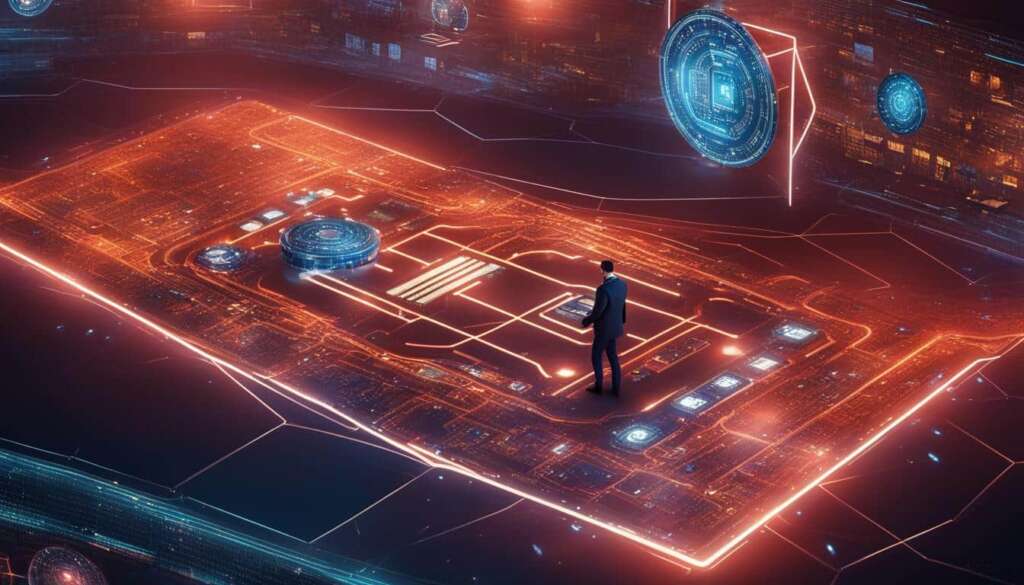Table of Contents
Is the decentralized web the future of internet freedom? As the web evolves, concerns about centralized control and censorship are growing. The concept of web decentralization, also known as web3.0, blockchain web, or peer-to-peer web, offers a potential solution. By shifting towards a distributed web architecture, we can create a more open and accountable internet of the future.
But what exactly is the decentralized web? And how does it address the challenges posed by mega-platform consolidation and lack of user control? In this article, we will explore the benefits and challenges of the decentralized web and its potential to foster internet freedom.
The Need for Decentralization
The current state of the Web is characterized by large, corporate-controlled platforms that have significant control over the flow of information. These platforms have the power to censor content and curate information based on their own algorithms, leading to concerns about bias and lack of accountability. The need for decentralization arises from the desire to create a more open and free internet where users have more control over their own data and content.
In a decentralized web, power is distributed among users rather than concentrated in the hands of a few centralized entities. This enables individuals to freely express themselves, share information, and access a variety of perspectives without fear of censorship or manipulation. By removing the intermediaries and gatekeepers that currently dominate the online landscape, a decentralized web promotes internet freedom and democratizes the digital space.
“Decentralization is the key to ensuring that the internet remains a global public resource that serves the interests of its users, rather than a tool for control and manipulation by powerful entities.”
Decentralization also addresses concerns about privacy and data security. In a centralized system, user data is stored on servers controlled by a single entity, making it vulnerable to breaches and unauthorized access. A decentralized web, built on technologies such as blockchain, ensures that data is distributed across a network of nodes, making it more secure and resistant to cyberattacks.
| Benefits of Decentralization | Challenges of Decentralization |
|---|---|
|
|
The Promise of Decentralized Systems
Decentralized systems, powered by blockchain technology, are revolutionizing the way we interact and transact online. These systems rely on a peer-to-peer network and a distributed ledger to ensure transparency, security, and trust without the need for intermediaries. The potential of decentralized systems lies in their ability to eliminate the concentration of power and enable user-centric experiences.
Blockchain technology, in particular, has gained immense popularity due to its decentralized nature. It allows for trustless transactions and eliminates the need for central authorities. With blockchain, every transaction is recorded on a transparent and immutable distributed ledger, ensuring the integrity of the data. This technology forms the foundation for the Decentralized Web, offering a promising future for internet freedom.
Decentralized systems, such as blockchain technology, offer the promise of a more secure and transparent internet. These systems rely on a peer-to-peer network and a distributed ledger to coordinate and verify transactions without the need for intermediaries.
One of the key advantages of decentralized systems is their ability to foster innovation and collaboration. Unlike traditional centralized platforms, which often have strict rules and limitations, decentralized systems encourage developers and users to contribute to the growth and improvement of the network. This open and inclusive approach allows for the creation of diverse and user-driven applications that can better serve the needs of individuals.
Furthermore, decentralized systems promote data privacy and control. With the rise of centralized platforms, concerns about data collection, surveillance, and the misuse of personal information have become prevalent. Decentralized systems aim to address these concerns by giving users ownership and control over their data. By leveraging cryptographic principles, individuals can securely store and share their data without the risk of it being exploited or misused.
The Benefits of Decentralized Systems
- Increased security and transparency
- Elimination of intermediaries
- Promotion of innovation and collaboration
- Enhanced data privacy and control
As the technology continues to evolve and mature, decentralized systems have the potential to transform various industries, including finance, supply chain management, and healthcare. The promise of a more inclusive, secure, and user-centric internet powered by decentralized systems is a vision that is attracting increasing attention and investment.
| Decentralized Systems | Advantages |
|---|---|
| Blockchain Technology | – Trustless transactions – Elimination of central authorities – Transparent and immutable ledger |
| Peer-to-Peer Network | – Enhanced security – Elimination of intermediaries – Efficient data transfer |
| Distributed Ledger | – Increased transparency – Improved data integrity – Enhanced auditability |
The promise of decentralized systems lies in their ability to empower individuals, foster collaboration, and redefine the way we interact and transact online. As we look towards the future, it is important to recognize the potential of decentralized systems in creating a more inclusive, secure, and user-centric internet.
Addressing Mega-Platform Consolidation
The consolidation of power in mega-platforms has become a pressing concern in today’s digital landscape. These platforms, such as Facebook, Google, and Amazon, have amassed significant control over the flow of information, raising issues of censorship, bias, and lack of competition. To combat this centralization, the Decentralized Web movement is championing the concept of decentralized publishing.
Decentralized publishing projects, like Freedom Box, Diaspora, Mastodon, Blockstack, IPFS, Solid, Appcoins, and Steemit, aim to put users back in control of their content. By utilizing decentralized technologies, these projects offer alternatives to centralized platforms by enabling direct user control and ownership. This shift towards user-centric platforms fosters greater competition and choice, empowering individuals to shape their digital experiences according to their preferences.
One of the primary advantages of decentralized publishing is its ability to address censorship. With mega-platform consolidation, there is a risk that certain voices and perspectives may be silenced or marginalized. Decentralized publishing projects provide a decentralized architecture that ensures online content can be published and accessed freely and without fear of censorship. This enables a more diverse and inclusive digital ecosystem where a variety of ideas can flourish.
Decentralized Publishing Projects
Here is a selection of some notable decentralized publishing projects:
| Project | Description |
|---|---|
| Freedom Box | A personal server that enables users to have more control over their online presence and data. |
| Diaspora | A decentralized social media platform that allows users to connect and share content without a central authority. |
| Mastodon | An open-source, decentralized microblogging platform that provides an alternative to centralized social media networks. |
| Blockstack | A decentralized internet built on blockchain technology, allowing users to control their data and identities. |
| IPFS | A peer-to-peer protocol that enables the decentralized storage and sharing of files. |
| Solid | A decentralized web platform that gives users control over their own data and improves data interoperability. |
| Appcoins | Digital currencies that provide incentives for users to participate in the growth of decentralized systems. |
| Steemit | A decentralized social media platform that rewards users with cryptocurrency for creating and curating content. |
The Rise of the Appcoin
As the Decentralized Web continues to gain momentum, a new concept has emerged – the appcoin. Appcoins are digital currencies that play a crucial role in incentivizing and rewarding user participation within decentralized systems. These currencies provide a means for users to financially participate in the ownership of platforms and protocols, creating a more inclusive and democratic ecosystem.
Unlike traditional digital currencies like Bitcoin, appcoins are specifically designed to be used within decentralized applications (DApps). They serve as a form of native currency within these applications, allowing users to perform various actions, such as purchasing goods and services, accessing premium features, or even voting on protocol upgrades.
The use of appcoins helps foster community engagement and active participation within decentralized systems. By providing financial incentives, appcoins encourage users to contribute their time, skills, and resources to the growth and development of the network. This creates a more vibrant and collaborative environment where everyone has a stake in the success of the platform.

Challenges of Decentralized Systems
The adoption of decentralized systems poses various challenges that need to be addressed for widespread usage and success. These challenges include:
- User Adoption: While the technical feasibility of decentralized systems is evident, gaining user adoption is crucial for their viability. Educating users about the benefits and functionality of these systems is essential in overcoming the initial learning curve.
- Technical Feasibility: Implementing and maintaining decentralized networks and protocols require specialized technical knowledge. Ensuring the scalability, efficiency, and interoperability of these systems is necessary for their long-term viability.
- Security: Decentralized systems operate on the principle of user-controlled cryptographic keys. This places the responsibility of securing these keys on the users themselves. Inadequate security measures can result in potential breaches and theft of sensitive information.
- Monetization: The traditional advertising-based business models that dominate the centralized web may not directly translate to decentralized systems. Finding sustainable monetization models that incentivize developers while preserving user privacy and autonomy is a challenge that needs to be addressed.
- Market Consolidation: While the Decentralized Web aims to decentralize power, there is a risk of market consolidation among decentralized platforms. Ensuring a diverse and competitive landscape is essential for preventing the emergence of centralized control within decentralized systems.
Addressing these challenges requires collaboration between developers, users, and policymakers to create user-friendly interfaces, robust security measures, sustainable business models, and regulations that foster competition and innovation.
Decentralized systems offer immense potential for fostering internet freedom and empowering users. However, overcoming the challenges of user adoption, technical feasibility, security, monetization, and market consolidation is crucial for their widespread adoption and success.
| Challenges | Impact | Solution |
|---|---|---|
| User Adoption | Limited user base | User education and user-friendly interfaces |
| Technical Feasibility | Scalability and interoperability issues | Ongoing research and development |
| Security | Potential for breaches and theft | Robust security measures and user education |
| Monetization | Need for sustainable revenue models | Alternative revenue streams and incentivization mechanisms |
| Market Consolidation | Risk of centralized control | Regulations that foster competition and prevent monopolies |
The Vision of Web 3.0
The concept of Web 3.0 aligns closely with the vision of the Decentralized Web, aiming to create a future where the internet is based on public blockchains and characterized by decentralization, permissionless access, and trustlessness. This vision seeks to eliminate the need for central authorities and intermediaries, allowing individuals to have more control over their online interactions.
Web 3.0 envisions a paradigm shift from the current model of centralized platforms to a decentralized architecture. Public blockchains form the foundation of this vision, enabling transparent and secure transactions without relying on a single point of control. By utilizing blockchain technology, Web 3.0 aims to empower users by giving them ownership and control over their data, ensuring privacy and fostering a more open internet ecosystem.
The key principles of Web 3.0 are decentralization, permissionless access, and trustlessness. Decentralization moves away from the dominance of centralized platforms, enabling power to be distributed among a network of participants. Permissionless access ensures that anyone can join and contribute to the network without requiring approval from a central authority. Trustlessness, achieved through cryptographic algorithms and verification processes, eliminates the need to trust intermediaries, providing transparency and security.
| Principles of Web 3.0 | Description |
|---|---|
| Decentralization | Moving away from centralized platforms and distributing power among participants |
| Permissionless Access | Allowing anyone to join and contribute without needing approval |
| Trustlessness | Eliminating the need to trust intermediaries through cryptographic algorithms |
Web 3.0 represents a paradigm shift in the way we conceive and interact with the internet. By embracing public blockchains and decentralization, Web 3.0 has the potential to revolutionize various aspects of our lives, from finance to social interactions. It envisions an internet that is more transparent, secure, and user-centric, where individuals have greater control over their data and online experiences. The future of the internet lies in the hands of Web 3.0, where the power is distributed among its users, fostering freedom and innovation.
The Evolution of the Web
The evolution of the Web can be categorized into three stages: Web 1.0, Web 2.0, and Web 3.0. Each stage represents a significant shift in how the internet is used and experienced.
Web 1.0: The Read-Only Web
Web 1.0, also known as the read-only web, refers to the early days of the internet when websites were static and users primarily consumed content. During this stage, the web primarily served as an information resource, with limited interactivity and user participation. Websites were built using HTML and displayed basic text and images.
Web 2.0: The Interactive Web
Web 2.0 marked a significant shift in how people interacted with the internet. It introduced the concept of user-generated content, social media platforms, and interactive web applications. Instead of simply consuming information, users now had the ability to create, share, and collaborate online. Web 2.0 technologies, such as blogs, wikis, and social networking sites, empowered individuals to actively contribute to the web.
Web 3.0: The Decentralized Web
Web 3.0, also referred to as the decentralized web, is the next stage in the evolution of the internet. It envisions a future where the web is built on decentralized systems, such as blockchain technology, allowing for greater transparency, security, and user control. Web 3.0 aims to eliminate the reliance on centralized authorities and intermediaries, enabling direct peer-to-peer interactions and decentralized applications (DApps).
| Web Stage | Characteristics |
|---|---|
| Web 1.0 | Read-only web, static websites, limited interactivity |
| Web 2.0 | Interactive web, user-generated content, social media, web applications |
| Web 3.0 | Decentralized web, blockchain technology, transparency, user control |
As we move towards Web 3.0, the internet is poised for another transformation. The decentralized web holds the potential to revolutionize how we interact with information, services, and each other online. By embracing decentralized systems and technologies, we can reshape the internet into a more open, transparent, and user-centric ecosystem.
Properties of Web 3.0
Web 3.0 applications, also known as decentralized apps or DApps, are built on blockchain technology and offer several key properties. These apps are decentralized, meaning they do not rely on a single server or database. Instead, they operate on a distributed network of computers, ensuring that no single entity has control over the app. This decentralized nature enhances security, removes censorship risks, and promotes a more transparent and trustworthy user experience.
One of the defining features of Web 3.0 apps is their utilization of blockchain technology. Blockchain provides a secure and immutable ledger that ensures the integrity of transactions and data. Each transaction is recorded in a block, and these blocks are linked together, forming a chain. This decentralized and transparent system eliminates the need for intermediaries, reduces the risk of fraud, and increases trust among users.
Incentives play a crucial role in the success of Web 3.0 apps. Unlike traditional apps, which are typically driven by profit motives, decentralized apps incentivize user participation and contribution. This can take the form of app-specific tokens or cryptocurrencies, which users can earn by providing valuable services, contributing computing power, or participating in the network governance. These incentives foster a collaborative and community-driven ecosystem, where users are rewarded for their contributions to the network.
Another key property of Web 3.0 apps is user control. Unlike centralized apps, where user data is often stored and controlled by a central authority, decentralized apps give users ownership and control over their data. Users can decide how their data is stored, who has access to it, and can even monetize their data if they choose to do so. This shift towards user control empowers individuals, promotes privacy, and reduces the risk of data breaches or misuse.

The properties of Web 3.0 apps, including decentralization, blockchain technology, incentives, and user control, are revolutionizing the way we interact with the internet. These apps offer a more secure, transparent, and user-centric experience, where individuals have greater autonomy over their online activities. As the technology continues to evolve, we can expect to see even more innovative applications and advancements in the realm of Web 3.0.
The Revolution of Web 3.0
Web 3.0 is not only transforming the internet but also revolutionizing various aspects of finance. At the forefront of this revolution is decentralized finance, or DeFi. DeFi enables real-world financial transactions to occur on the blockchain, bypassing traditional intermediaries like banks. By leveraging cryptocurrency and smart contracts, DeFi brings accessibility, transparency, and inclusivity to financial services.
Financial transactions within the DeFi ecosystem are conducted using cryptocurrency, such as Bitcoin or Ethereum. These digital currencies offer secure and immutable transactions, ensuring that funds can be transferred without the need for intermediaries. This removes the dependence on banks or centralized authorities, providing individuals with greater control over their finances.
One of the key advantages of DeFi is the ability to access financial services without permission from central entities. This decentralized nature empowers individuals to participate in financial activities without relying on traditional systems that may exclude certain individuals or require lengthy approval processes. DeFi opens up opportunities for individuals who are unbanked or underbanked to access essential financial services.
The rise of DeFi also challenges the concentrated power of centralized financial institutions. By decentralizing financial services, DeFi aims to remove the need for intermediaries and reduce their influence over the control and distribution of wealth. Instead, the power is shifted towards the community, enabling peer-to-peer transactions and greater financial autonomy.
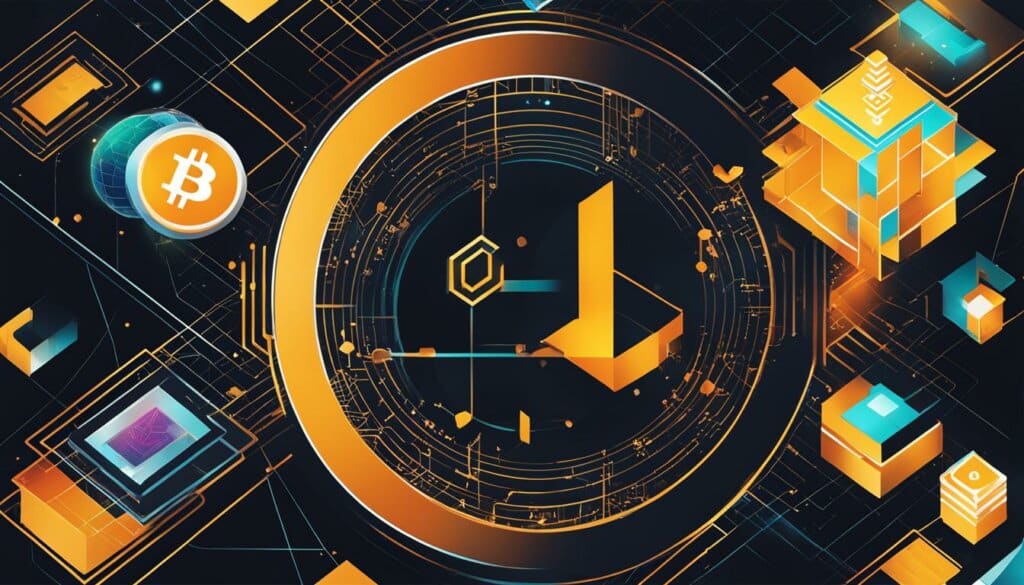
| Advantages of DeFi | Challenges of DeFi |
|---|---|
|
|
While the potential of DeFi is immense, there are challenges that must be addressed to ensure its sustainable growth. Regulatory compliance is one such challenge, as governments around the world grapple with how to regulate this emerging field. Cybersecurity risks also need to be mitigated to protect users’ funds and personal information.
User education and adoption play a crucial role in the success of DeFi. As the technology becomes more complex, it is important to empower users with the knowledge and tools to navigate the ecosystem securely. Additionally, the lack of established infrastructure for DeFi poses challenges in terms of scalability and interoperability.
Conclusion
DeFi represents a fundamental shift in how financial services are accessed and utilized. Its decentralized nature challenges the traditional financial system, empowering individuals with greater control over their finances. However, to fully unlock the potential of DeFi, regulatory frameworks, cybersecurity measures, and user education need to be addressed. With continued innovation and collaboration, DeFi has the potential to reshape the financial landscape and bring financial freedom to individuals worldwide.
Conclusion
The Decentralised Web offers a promising future for internet freedom. By shifting control from centralised platforms to decentralised systems, users can have more autonomy and privacy in their online interactions. It addresses concerns about censorship, bias, and lack of accountability that arise from the consolidation of power in large corporate-controlled platforms.
Decentralised systems, such as blockchain technology, form the foundation for the Decentralised Web. These systems provide a more secure and transparent internet experience by eliminating the need for intermediaries and enabling trustless transactions. They offer solutions to issues like censorship, data portability, and interoperability that are often lacking in the current centralised web.
While there are challenges to overcome, such as user adoption, technical feasibility, security, monetisation, and market consolidation, the benefits of a decentralised web make it an important development in the evolution of the internet. Increased user choice, competition, and censorship resistance are among the key advantages offered by the Decentralised Web.
As we move towards Web 3.0, it is crucial to prioritise the values of decentralisation and internet freedom. The future of the internet lies in empowering users and creating a more open and free online environment.
FAQ
What is the Decentralized Web?
The Decentralized Web refers to the concept of shifting control from large, corporate-controlled platforms to decentralized systems, such as blockchain technology. It aims to promote internet freedom and give users more control over their data and content.
Why is the Decentralized Web important?
The current web is dominated by large platforms that have significant control over the flow of information, leading to concerns about censorship and bias. The Decentralized Web offers a more open and free internet where users have greater autonomy and privacy.
What are decentralized systems?
Decentralized systems, such as blockchain technology, rely on a peer-to-peer network and a distributed ledger to coordinate and verify transactions without the need for intermediaries. They offer a more secure and transparent internet experience.
How does the Decentralized Web address mega-platform consolidation?
Decentralized publishing projects aim to provide users with direct control over their content and enable greater competition and user choice. These projects offer solutions to issues like censorship, data portability, and interoperability.
What are appcoins?
Appcoins are digital currencies that enable users to financially participate in the ownership of platforms and protocols. They provide incentives for developers and community members to contribute to the growth and development of decentralized systems.
What challenges do decentralized systems face?
User adoption, security, and monetization are major challenges. Technical feasibility alone does not guarantee widespread usage, and decentralized networks require users to manage their own cryptographic keys and navigate complex security protocols. Monetization is also a challenge, as advertising-based business models incentivize data collection and market consolidation.
What is Web 3.0?
Web 3.0 envisions a future where the internet is based on public blockchains, allowing for decentralized and permissionless access to services and transactions. It aims to eliminate the need for central authorities and intermediaries, creating a trustless environment where individuals have more control over their online interactions.
How has the Web evolved?
The Web has evolved from Web 1.0, which was a read-only web, to Web 2.0, which introduced interactivity and user-generated content. Web 3.0 is the vision of a decentralized and intelligent web, where users have more control over their data and interactions.
What are the properties of Web 3.0?
Web 3.0 applications, also known as decentralized apps or DApps, are built on blockchain technology and offer properties such as decentralization, incentives for user participation, and user control over data, providing a more transparent and secure internet experience.
How does Web 3.0 revolutionize finance?
Web 3.0 enables real-world financial transactions to occur on the blockchain without the need for traditional intermediaries like banks. This shift away from centralized power has attracted significant investments from major corporations and venture capital firms.
What is the future of the Decentralized Web?
The Decentralized Web offers a promising future for internet freedom by giving users more autonomy and privacy in their online interactions. While challenges exist, the benefits of a decentralized web, such as increased user choice, competition, and censorship resistance, make it an important development in the evolution of the internet.
Source Links
- https://dci.mit.edu/decentralizedweb
- https://cointelegraph.com/learn/what-is-web-3-0-a-beginners-guide-to-the-decentralized-internet-of-the-future
- https://helpdev.eu/understanding-decentralized-web-the-future-of-internet-freedom/

